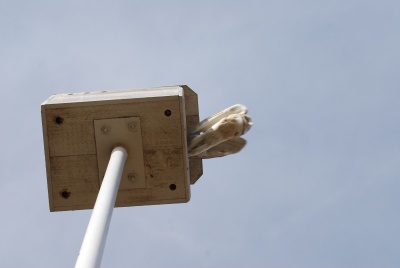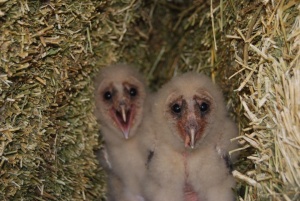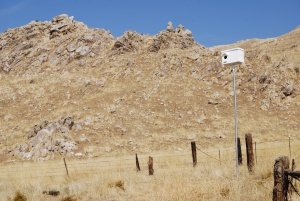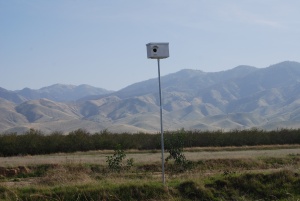When life gives you lemons, we’re told to make lemonade. But when troubled times came to Glenn Prichard earlier this year, he decided to go a different route and, instead of a frosty tart beverage, this Santa Clarita resident took up the task of creating and distributing nesting boxes so farmers can go organic and barn owls can find safe homes.
Once a league pitcher on a farm team for the Anaheim Angels (“drafted me right out of high school; played for five years before two elbow operations”), Prichard headed up his own construction company for 30 years. But with a downturned economy, he now finds satisfaction creating structures on a smaller scale – ones that connect wildlife to local farmers in a symbiotic way.
“It’s fulfilling and exciting,” Prichard says about his journeys into Central and Southern California farmlands where he meets farmers, erects nesting boxes and keeps tabs on how area barn owls are adjusting to their new abodes. “I enjoy this and it’s a lot less stress. I meet real down-to-earth people and it’s a way we can care for the environment together.”
Like most great ideas, the notion of working with owls came to him happenstance and through connections.
An outdoorsy fellow, Prichard volunteered at many local rescues (including local raptor rehab centers) and is a board member for a wolf rescue in Idaho, the Wolf Education Rescue Center (WERC). Through his relationships with WERC, Prichard hooked up with Portland-based Chris Anderson of Owl Brand Discovery Kits who sells owl pewk as an educational tool. (Yep, pewk, regurgitated owl prey barfed up in a tidy pellet package. Science teachers can raise their awesome factor when they bring these mystery pellets into a classroom for an afternoon of dissection and discovery…and hey, squeamish students, no blood!)
Prichard started traveling to local farms to collect pellets which he found under and in existing barn owl nesting boxes. To his dismay, he discovered many boxes hadn’t been maintained in years, some were caked with poop and caustic, some were badly broken with sides falling off. On the ground, he saw bones of dead babies and broken eggs lying in the dirt. Hmmmm……
Brain wheels in motion, Prichard became a quick and avid student of barn owls and nesting boxes. He talked with raptor experts (“barns owls are cavity dwellers, they have been known to tunnel inside hay bales to make nests”), read everything he could find about the bird (“they are nocturnal birds that swallow their prey whole”) and explored what makes a good nesting box (“a baffle wall protects the nesting eggs from unwanted paws”).
Overall, nesting boxes are relatively new additions to farms; a trend started in the late 1980s when “sustainable” was a new concept. By encouraging barn owls onto their property, farmers use the raptor’s natural hunger to keep pests – such as gophers, rats, field mice, voles and more – from destroying precious crops. No need for poisons and traps since barn owls are effective and always ready for another meal, especially when there are babies with open beaks back home. The raptors are not territorial (you can have a lot of owls in the area, they don’t mind the company), don’t migrate, only hunt at night, and will keep coming back if there’s enough food and shelter.
Prichard established his newest venture this year, Nature’s Remedy, and through it, he offers nesting boxes, (handmade by a local disabled war veteran) and lifetime maintenance on leasing boxes for any size farms.

He assists farmers in placing the right size boxes in the right location. Too often, he discovered boxes were routinely placed on power poles (“a big no-no!”) and affixing them to trees only invites raccoons and other hungry critters to go after eggs and owlets. The best solution is putting a nesting box on atop a platform on a free-standing pole. Voila – a room with a view.
Today, Prichard travels farmlands erecting and cleaning nesting boxes as well as preaching the gospel of Let Nature Help You. “Part of what I do when I’m out there in the fields is education, helping farmers understand that baiting and trapping pests can lead to other problems, especially when you leave poisoned animals out there for others to eat,” he says.
In the last six months, Prichard has placed 60 boxes at area farms. On the average, boxes cost about $100 to make and $250 to maintain for its life span with is about 5-7 years. Prichard’s goal is to place as many as he can, but he’s discovered that even asking what seems like a small amount for his goods and services doesn’t fit in many farm budgets. Some farms can accommodate up to 30 boxes; acreage is after all, everything.
That’s why Prichard’s Nature’s Remedy teamed up with the folks at WERC and Owl Brand Discovery Kits to create the non-profit HOOT Project, a way for everyday citizens to financially help the cause of bringing nesting boxes to farm fields. Donations help Prichard continue his work, and even if money isn’t flowing in buckets, he says “I’ll put up as many as I can, whether the donations come or not because I truly believe in this.”
Maybe the cause resonates with Prichard because this current career has given him newfound energy. If he’s not out in the fields or building boxes, Prichard is researching ways to introduce the nesting box ideal to scouting troops, high school woodshop classes and big home improvement businesses that could eventually sponsor the project with wood donations. “Tons of potential, a lot of interest,” he says. “Lot of work to do.”
Of all the titles he’s had – athlete, construction expert, self-made businessman, entrepreneur – Prichard gets a kick out of his new moniker: “When they see me coming, the farmers holler, ‘Hey, here comes the Owl Guy,’’ he says with a laugh. “Sure, I used to be an Angel, but now I’m picking up owl pewk, but I wouldn’t have it any other way. I’m right where I belong.”
Click here to learn more about the HOOT project.
By Brenda Rees; Photos courtesy of Nature’s Remedy





